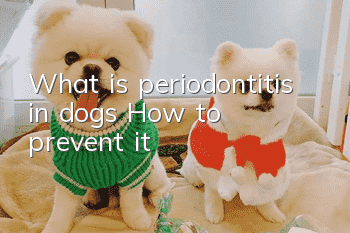What is periodontitis in dogs? How to prevent it?

Periodontitis in dogs
Periodontitis is an acute or chronic inflammatory process involving the periodontium, namely the gingival margin, periodontal pockets, periodontal ligament and alveolar bone. Periodontal disease caused by bacterial activity has plaque and calculus adhered to the tooth surface. Because of the mechanical stimulation produced by plaque and calculus and the release of toxic products from bacteria, plaque and calculus cause soft tissue inflammation along the gingival margin. If not treated in time, the further development of inflammation will cause the gums and alveolar bone tissue to shrink, which in turn will cause gum recession, alveolar bone resorption, and tooth loosening. In addition, the disease can easily be caused by damage to the gingival tissue and irregular tooth arrangement, a low-calcium diet, or oral bacteria invading the gums and destroying the periodontal membrane tissue during the disease process.
Diagnosis
Symptoms include bad breath, salivation, red gums, swelling, softening, atrophy, exposed tooth roots, loose teeth, and purulent secretions or extrusion in the gums Purulent discharge from the gums. Radiographs showed localized alveolar osteolysis, indicating an apical abscess.
Prevention
Remove dental plaque, stones and food residues under anesthesia. Attention should be paid to removing plaque and calculus from the submarginal root surface (i.e., within the periodontal pockets). Polish all tooth surfaces whenever possible to prevent plaque and stones from reaccumulating and adhering. Remove loose teeth. For persistent periodontitis, the associated teeth should be extracted. If your gums are enlarged, excess tissue can be removed with electrocautery. Use iodine glycerin after surgery. Systemic use of antibiotics, vitamin B complex, niacin, etc.
Preventive measures include frequent oral and tooth examinations and regular cleaning of tartar with gauze. Feed solid food. Give large bones or large chews, etc., to exercise the teeth and gums. Giving Dalbergia dry food can help prevent the occurrence of periodontitis.
- How to tell if your dog is fat? Is your dog overweight?
- Will your dog catch a cold if you blow the air conditioner? What should you do if your dog catches a cold if you blow the air conditioner?
- The dog's mouth bites and shakes. Why does the dog's mouth occasionally shake and bite?
- How to cut a dog's hair? Do you know how to cut a dog's hair correctly?
- Can dogs eat raw eggs? Why can’t dogs eat egg whites?
- Common Dog Problems in Summer How to Deal with Different Dog Problems
- How to keep dogs away from skin diseases. If you do this, will you see if your dog will still be infected with skin diseases?
- What causes anorexia in dogs? Dogs will become anorexic due to lack of exercise. Hounds run at least 5KM every day.
- Can dogs eat liver? What should you pay attention to when giving liver to your dog?
- Can canine herpes virus be transmitted to humans? Owners should not be too nervous



